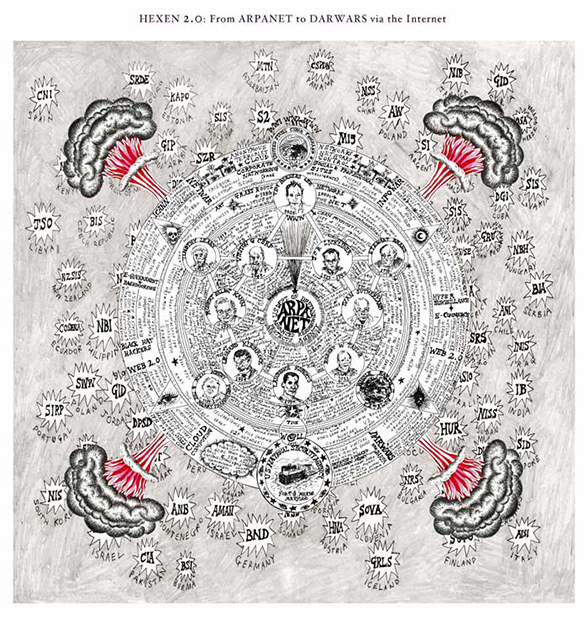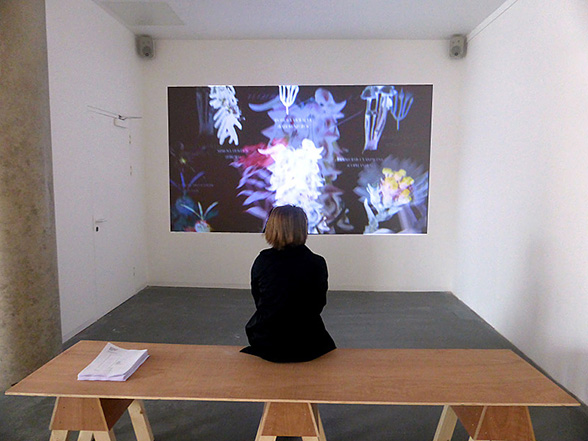Suzanne Treister: Challenging the Art World from Within
Posted on 23 September 2016 by Liverpool Biennial

Suzanne Treister, HFT The Gardener/Video stills and photo works/High Frequency Trading Floor (digital print), 2014-15. Courtesy the artist
Suzanne Treister, HFT The Gardener/Video stills and photo works/High Frequency Trading Floor (digital print), 2014-15. Courtesy the artist
Interested in the covert, unseen forces at work in the world – whether corporate, military or paranormal – British artist Suzanne Treister has been a pioneer in the field of new media art since the early 1990s. Experimenting with video, the Internet, interactive technologies, photography, drawing and watercolour, her projects often span several years at a time, developing into fictional worlds and international collaborative organisations. We catch up with Treister about her most recent piece, HFT The Gardener, which is presented at LJMU’s Exhibition Research Lab for Liverpool Biennial 2016, and at Annely Juda Fine Art in London.
Can you tell us a bit about the type of art you make and the themes you tend to explore within your work?
Themes in my work have included and revolve around history, politics, the frontiers of science and technology, para-science and alternative belief systems, structures of power and control, and futurology, among others.
In the 1980s, I was making semi-narrative paintings which were about modellings of history, politics and belief. By the late 80s, however, I began making work about video games. In 1991, I bought an Amiga computer and used this to make a series of fictional video game stills (1991-2), which led to a project about imaginary software packages (1993-4).
Over the course of the 1990s, I more or less left the mainstream art world, and became involved in the new media art scene and collaborative groups. I was working on web-based projects and an interactive CD-ROM video game about a time travelling avatar/alter-ego, Rosalind Brodsky, who worked at a military institute from the future. Subsequent projects, such as HEXEN 2039 (2005-6), which documented the supposed research projects of the military institute, grew out of this.

HEXEN 2.0/Historical Diagrams/From ARPANET to DARWARS via the Internet (2009-11). Courtesy the artist
These more recent works could be viewed in a similar way to political science fiction, if you like. Since then, HEXEN 2.0 (2009-11), for example, mapped histories of scientific research behind government programmes of mass control, investigating parallel histories of countercultural and grass roots movements with the intention of imagining possible futures. Post-Surveillance Art (2014) was trying to illuminate a new paradigm.
Could you briefly describe your Liverpool Biennial 2016 exhibition and what it is about?
Titled HFT The Gardener, the exhibition comprises of 175 drawings and computer works by the fictional character Hillel Fischer Traumberg. Traumberg is an algorithmic high-frequency trader (HFT), who experiments with hallucinogenic drugs and explores the ethno-pharmacology of over a hundred psychoactive plants. He uses gematria (Hebrew numerology) to discover the numerological equivalents of the plants’ botanical names against the companies listed in the Financial Times Global 500 Financial Index. He also communes with the traditional shamanic users of these plants, whose practices include healing, divining the future, entering the spirit world and exploring the hallucinatory nature of reality.

HFT The Gardener, 2016. Installation view at Exhibition Research Lab. Courtesy the artist
Traumberg develops a fantasy of himself as a techno-shaman, transmuting the spiritual dimensions of the universe and the hallucinogenic nature of capital into new art forms. Influenced by the drawings of Adolf Wölfli, which he saw on a banking trip to Switzerland, he becomes an 'outsider artist' whose works are collected by oligarchs, bankers, museums and some of the corporations featured in the works. Traumberg continues his parapsychopharmacological research and works on a new algorithm to discover the true nature and location of consciousness, and to determine whether psychoactive drugs open a portal to the holographic universe.

HFT The Gardener, 2016. Installation view at Exhibition Research Lab. Courtesy the artist
The exhibition takes place in the Exhibition Research Lab of the Liverpool School of Art and Design, an institution which trains artists. How do you feel this affects the story of its central character, Traumberg, an isolated and self-taught artist?
One of the starting points of the HFT project was my disappointment with the increasing monetisation of ‘outsider art’ over the past few years. Specifically, the way that parts of the mainstream art world, hungry for the 'authentic' in the wake of the professionalisation of contemporary artists, have mined and inevitably capitalized on the works of ‘outsider artists’, many of whom are either dead or in care homes around the world. I wanted to upend this narrative by inventing a banker who becomes an ‘outsider artist’. As such, high finance and economics revert to the 'authentic', deeper experiences often lost in the military-academic-corporate-government-industrial-techno-scientific-complex. So in that sense, among others, I would like this to be a thought provoking show for art students at LJMU.
The video within the exhibition gives the show a somewhat ‘documentary’ feel, and in many cases, people have mistakenly believed Traumberg to be real. Is this something you intended?
That would be like the writer of a novel expecting people to think their characters are real. However, the temporary suspension of everyday thinking would probably provide people with a more valuable experience of the ideas within the exhibition. The narrative voiceover in the video tells the full story of HFT, and is supposed to give a clear introduction to the works as well as being one of the works itself (although, unlike the works on paper, the video is not supposedly by Traumberg but narrated by an unknown commentator). Also, taking into account the stylistic influence of ‘outsider artist’ Adolf Wölfli on both Traumberg and myself, it is clear that the project has several layers of authorship.

HFT The Gardener, 2016. Installation view at Exhibition Research Lab. Courtesy the artist
You adopted the personality of Traumberg for an extended period as part of the exhibition process. Can you describe what this was like and how you think the experience might affect your work in the future?
Although my interests and Traumberg's were often one and the same during the making of the work (much like how a novelist might carry out a lot of background research and attempt to ‘get inside’ their fictional characters), I don't feel I adopted his personality. I mentioned earlier that Rosalind Brodsky was my avatar/alter-ego in the 1990s, but I don't think of Traumberg in that way. Brodsky and I shared a lot of personal 20th century history. HFT is more of an abstract construct, rather than a personality. It is even suggested in one of the works that he may be an algorithm.
Unlike many of your previous projects, HFTdeals with a primarily isolated, introspective individual who becomes increasingly fixated on the notion of consciousness. Was this in any way intended as a reflection on how ‘outsider artists’ tend to make work, which is perhaps less shaped towards a particular art world audience?
This is a tricky question because I do not make work specifically aimed at an art world audience. Since launching my first web project in 1995, I've been very aware of non-art world audiences, and these have been really important for me.
But yes, as HFT transforms himself into an ‘outsider artist’ through his use of hallucinogenic drugs, he becomes increasingly involved in these big questions of consciousness and theories of the universe. Questions he is, perhaps, more able to hypothesise scientific answers to because of his professional background. Like HFT, the art world is becoming increasingly filled with multi-disciplined people (who once were astrophysicists or geographers for example) who are – often willingly – swallowed up by the novelty hungry art world, just like ‘outsider artists’ have been.
What other projects and exhibitions have you got underway?
The Tarot works from HEXEN 2.0 and a newly commissioned drawing, From Psychedelics via the Counterculture to the Possible Futures of Humanity (2016), are currently on show as part of You Say You Want a Revolution? Records and Rebels 1966-1970 at the Victoria and Albert Museum in London, until February next year. HFT The Gardener will also be shown in London at Annely Juda Fine Art until 29 October this year.
I am also thinking about a new project at the moment, which will possibly be to do with future societies and the interplanetary internet, space travel, stars and techno-shamanism. I can't say for sure right now.
Visit HFT The Gardener at LJMU's Exhibition Research Lab until 16 October, open daily 10am-5pm, free.
Suzanne Treister's Reading List
Plants of the Gods: Their Sacred, Healing, and Hallucinogenic Powers (1979) by Albert Hofmann and Richard Evans Schultes
The Encyclopedia of Psychoactive Plants: Ethnopharmacology and Its Applications (2005) by Christian Rätsch
Breaking Convention: Essays on Psychedelic Consciousness (2013)
The Holographic Universe (1991) by Michael Talbot
Flash Boys: Cracking the money code (2014) by Michael Lewis
The Fear Index (2011) by Robert Harris
The Art of Adolf Wölfli: St. Adolf-Giant-Creation (2003) by Elka Spoerri and others
Art Forms in Nature: Prints of Ernst Haeckel (originally published 1899) by Olaf Breidbach and Irenaeus Eibl-Eibesfeldt
Publication: HFT The Gardener, Suzanne Treister
Liverpool Biennial
55 New Bird Street
Liverpool L1 0BW
- T +44 (0)151 709 7444
- info@biennial.com
Liverpool Biennial is funded by
Founding Supporter
James Moores